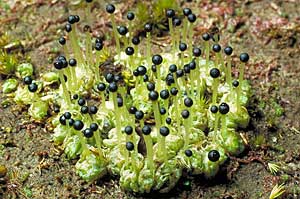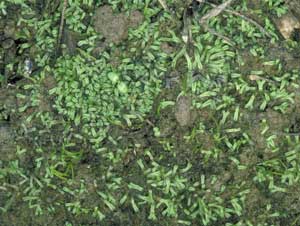
Ecology - Habitats
Cyclic, ephemeral habitats
Environmental disturbances come in many forms and magnitudes. Some are occasional, unpredictable and often very destructive. Examples of these are landslides, cyclones and wildfires. However, these disturbances also create opportunities. A major landslide exposes a large area of fresh soil. A severe wildfire leaves the ground barren and charred over an extensive area. A cyclone leaves a lot of dead wood and creates gaps in the forest canopy. In each case there are new substrates and modified habitats. There are bryophytes that will exploit the changes. In some cases the bryophytes that were present before the disturbance will colonize the fresh soil, the dead wood or the charred ground. In other cases specialist pioneer species will be the first in. In the FIRE SECTION you'll find a detailed account of the stages in bryophyte colonization after a major wildfire has swept through an area.
There are also disturbances which, unlike the examples listed above, are not catastrophic from a human point of view and which occur with something approaching clockwork regularity. These, quasi-regular disturbances are the subject of this page. Examples are the annual ploughing of fields, the periodic controlled burning for landscape management and the fall of leaves from tropical vascular plants. These are disturbances which register little, or not at all, with humans. Ploughing? Oh yes, happens every year. I don't really think about it. It's just ...normal. The fall of leaves from a tropical tree? That's a disturbance? But look at that from a bryophyte level. The leaves of tropical vascular plants commonly have bryophytes ![]() growing on them. Such bryophytes are called EPIPHYLLOUS BRYOPHYTES. When such a leaf falls to the forest floor, perhaps a year or so after formation, the bryophytes on it are doomed. Other forest litter will fall on them, they'll be deprived of light and they'll die. Of course, new leaves develop on the tree, are colonised by bryophytes and, in turn, fall to the ground – and so the cycle will continue. While each vascular leaf has a relatively short life (and is therefore ephemeral) the "leaf habitat" is regularly re-created. In this way we can say that, from a bryophyte perspective, the vascular leaves provide a cyclic, ephemeral habitat. The gametophyte of a bryophyte growing on a vascular leaf has to be a fairly quick grower. If it's too slow the host leaf will fall before the bryophyte has had a chance to reproduce. Moreover, the production of antheridia and archegonia takes time, they need the appropriate environmental triggers , successful fertilisation has to occur and more time is needed if sporophytes are to grow. Not surprisingly very efficient means of vegetative reproduction have evolved in many epiphyllous bryophytes.
growing on them. Such bryophytes are called EPIPHYLLOUS BRYOPHYTES. When such a leaf falls to the forest floor, perhaps a year or so after formation, the bryophytes on it are doomed. Other forest litter will fall on them, they'll be deprived of light and they'll die. Of course, new leaves develop on the tree, are colonised by bryophytes and, in turn, fall to the ground – and so the cycle will continue. While each vascular leaf has a relatively short life (and is therefore ephemeral) the "leaf habitat" is regularly re-created. In this way we can say that, from a bryophyte perspective, the vascular leaves provide a cyclic, ephemeral habitat. The gametophyte of a bryophyte growing on a vascular leaf has to be a fairly quick grower. If it's too slow the host leaf will fall before the bryophyte has had a chance to reproduce. Moreover, the production of antheridia and archegonia takes time, they need the appropriate environmental triggers , successful fertilisation has to occur and more time is needed if sporophytes are to grow. Not surprisingly very efficient means of vegetative reproduction have evolved in many epiphyllous bryophytes.
What about dung? Dung is probably better known as a host for fungi than for bryophytes but there are some dung-inhabiting mosses, for example, some species in the genus Splachnum are strictly dung-inhabiting. As with leaves, so with dung – a given piece of dung is relatively short lived, subject to destruction by fungal decay, but fresh dung will always be deposited in a given area by the animals that live there. The spores of the dung-inhabiting Splachnum species are dispersed by flies and other dung-loving insects that are attracted by chemicals produced in the spore capsules of such mosses. Use of such insects means that a large proportion of the spores will be deposited on other pieces of dung whereas reliance on wind dispersal would result in a great wastage of spores.
Between ploughings
The annual agricultural cycle of plough, sow, harvest recreates the ephemeral habitat of ploughed soil at roughly the same time each year. Annually ploughed fields are very challenging environments, with the bryophytes that grow in such fields likely to be buried or chopped during the ploughing. Effectively this makes many of them annuals, relatively few being able to survive intact from one year to the next. Spores or vegetative propagules landing on the exposed soil would need to develop gametophytes fairly quickly if sporophytes are to be produced before the next ploughing. Another thing to bear in mind is that as the next crop in that field grows, there will be increasing shade. This would not be a problem to shade tolerant species, but shade intolerant ones would need to make the most of the early, unshaded period if they are to develop well. There certainly are species which can develop from spore or vegetative propagule to sporophyte between ploughings. However, as already noted earlier the production of antheridia, archegonia and sporophytes takes time. Another strategy for survival in such a habitat is to rely on tubers (or rhizoidal gemmae). Tuber production is a very effective strategy that allows a moss population to survive, year in year out, in a regularly and highly disturbed area. Tubers are known from many moss species, but there are far more species in which tuber production has not been seen. A tuber is more developed than a spore or a vegetative propagule and therefore allows much faster gametophyte development. In a similar manner, growth from a bulb of a vascular plant allows much faster plant establishment than does growth from a seed. It is interesting to note that many of the European mosses with rhizoidal gemmae are common in cultivated fields.
An activity such as ploughing, carried out regularly in a given area, will favour certain bryophytes over others. Over time certain bryophytes would disappear from such a habitat leaving just those best adapted to that disturbance – for example tuber-producing species or those able to develop sporophytes within a few months![]() .
.
Periodic control-burning
Periodic control-burning is done in many habitats in many parts of the world, for various purposes. It may be done to control weeds, promote grass growth for animal feed, reduce wildfire risk or maintain habitat for particular plant or animal species. Whatever the reason such burning is low level, the aim being not to destroy everything in an area. As with regular ploughing, regular control burning would also change the bryophyte species composition in an area. There were indications of this from a preliminary study of several temperate grasslands in Victoria, Australia. Their fire history varied, from being burnt annually for about 50 years to unburnt for 15 to 20 years (perhaps even longer). The leafy liverwort Lethocolea pansa ![]() , the thallose liverwort Fossombronia intestinalis and the moss Rosulabryum billardieri were present at all sites, while the leafy liverwort Chiloscyphus semiteres was absent from the annually burnt sites. The author suggested that the first three could tolerate a range of burning patterns, whereas the Chiloscyphus (an otherwise common and widespread species) was more sensitive
, the thallose liverwort Fossombronia intestinalis and the moss Rosulabryum billardieri were present at all sites, while the leafy liverwort Chiloscyphus semiteres was absent from the annually burnt sites. The author suggested that the first three could tolerate a range of burning patterns, whereas the Chiloscyphus (an otherwise common and widespread species) was more sensitive![]() .
.
Cyclic, ephemeral habitats or cyclic, ephemeral conditions
When a field is ploughed there is a definite change in the habitat – typically from compacted soil with crop stubble to broken up soil. After a control-burn fire there is a definite change in habitat. After the fire the ground is left with a light layer of ash and there is a significant reduction in plant cover.
Now think of the small earthen dams that are common in farms and reserves in many parts of Australia. Typically these are created by having a bulldozer create a depression, with the soil from the depression piled up to create walls. The photo ![]() shows such a dam in a state forest in central New South Wales. During the cooler, wetter months it fills but loses much by evaporation during the hot summer months. This dam had much more water in it some months before this photo was taken. You can see a muddy ring around the current water level and a drier area further away. In the muddy ring a bryologist is collecting thallose liverworts of the genus Riccia. It is in the muddy area that Riccia is at it's peak, with fertile thalli. In the drier areas Riccia will have finished, in the areas still under water there may be Riccia spores, ready to germinate once the water level has dropped sufficiently.
shows such a dam in a state forest in central New South Wales. During the cooler, wetter months it fills but loses much by evaporation during the hot summer months. This dam had much more water in it some months before this photo was taken. You can see a muddy ring around the current water level and a drier area further away. In the muddy ring a bryologist is collecting thallose liverworts of the genus Riccia. It is in the muddy area that Riccia is at it's peak, with fertile thalli. In the drier areas Riccia will have finished, in the areas still under water there may be Riccia spores, ready to germinate once the water level has dropped sufficiently.
As the water level drops the muddy ring decreases in size. One way of looking at it is to say there's a constantly contracting, ephemeral Riccia habitat. The photo on the right shows numerous thalli of Riccia multifida on the still damp area around another drying pond, this time a natural depression rather than one created by a bulldozer.
Some would say there's no change in habitat – just a change in conditions. During rain the water level in the dam rises. Later the water evaporates and leaves a ring of mud but there's no ploughing, no burning, no disturbance – hence no change in habitat. The counter argument is that the rising water level will drown many would be competitors, so creating a bare habitat for bryophyte colonisation.
So, change in habitat or change in conditions? Sometimes the border is a grey area and it's not really important. What is important is that many bryophytes have evolved ways of surviving a variety of harsh conditions and of responding to unpredictable and ephemeral benign periods. Some of those survival strategies also give an edge in periodically disturbed habitats. Periodic disturbances put pressure on bryophytes and, for many forms of periodic disturbance, there will be some groups of bryophytes which will be able to withstand those pressures. Of course the group of species that can tolerate annual grassland burning is different to the group that can tolerate ploughing or flooding.
![An Australian Government Initiative [logo]](/images/austgovt_brown_90px.gif)



